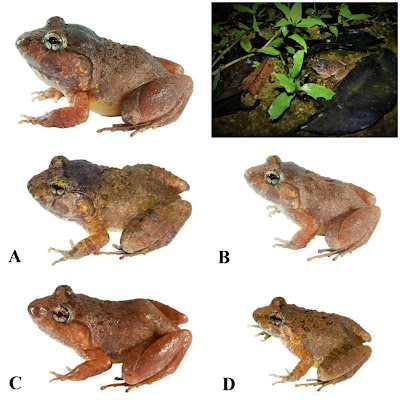 |
| Limnonectes pseudodoriae Yodthong, Rujirawan, Stuart & Aowphol, 2021 |
Abstract
A new species in the dicroglossid frog genus Limnonectes is described from Ko Pha-ngan, Ko Samui, and Ko Lanta Yai Islands in southern Thailand. Males of Limnonectes pseudodoriae sp. nov. lack a caruncle on top of the head and very closely resemble L. doriae (Boulenger, 1887) from Myanmar and western and southern Thailand. However, the new species is distinguished from L. doriae and its congeners using an integrative taxonomic approach of morphology, mitochondrial DNA, and bioacoustics. Limnonectes pseudodoriae sp. nov. differs from L. doriae and its congeners by having a unique combination of morphological characters, including body size; skin texture of the interorbital region, dorsum, and shank; toe webbing; relative size of the inner metatarsal tubercle; and coloration of the tympanum, venter, and ova. The advertisement call of the new species is also readily differentiated from that of L. doriae in temporal parameters. Limnonectes pseudodoriae sp. nov. is highly divergent in mitochondrial DNA from L. doriae and its congeners, but its phylogenetic position within the genus is not resolved. The natural history of the new species is presented, and the geographic range of L. doriae in Thailand is clarified.
Keywords: Amphibia; Limnonectes doriae; bioacoustics; mitochondrial DNA; Southeast Asia
Limnonectes pseudodoriae sp. nov.
Diagnosis: Limnonectes pseudodoriae sp. nov. is assigned to the genus Limnonectes on the basis of its inferred phylogenetic position (Figures 1 and 2), the presence of fang-like odontoid processes on the lower jaw [6,10], and enlarged heads with hypertrophied jaw musculature in adult males [6]. This species can be distinguished from its congeners by having the following combination of characters: (1) Small to medium body size, with SVL of adult males 42.6–48.2 mm (45.2 ± 1.7, n = 18), of adult females 36.0–44.1 mm (40.0 ± 2.8, n = 14); (2) males lacking cephalic caruncles, but having broadened convex skin with densely grained translucent spinules on the interorbital region from the level of the posterior margin of the eyes to the level of the posterior margin of the tympanum; (3) males with enlarged heads with hypertrophied jaw musculature; (4) two enlarged odontoid processes, triangular, sharp-tipped, angled posteriorly on anterior margin of the lower jaw, larger in adult males than females; (5) tympanum dark brown with yellow mottling, horizontal diameter in adult males greater than that of the eye, in juveniles and females less than that of the eye; (6) dorsum with enlarged, oval tubercles, and slightly elongated tubercles, not arranged in rows; (7) dorsal surface of shank covered with small, distinct, moderately dense, homogenously-sized tubercles tipped with translucent spinules; (8) chin and throat yellowish white with dark brown or gray mottling (9) chest, belly, ventral surface of upper forelimb and groin yellowish white; (10) ventral surfaces of forelimbs and hindlimbs orange-yellow; (11) Toe V with raised, but unmovable dermal ridge along outer margin; (12) inner metatarsal tubercle length approximately 35% that of Toe I; (13) toe webbing formula: I0−2II0−2 1 2 III0−(21 2 -3)IV(21 2 -3)−0V; and (14) ova with pigmented poles.
Etymology: The specific name pseudodoriae is a noun in apposition. The Greek word pseudo means “false” or “resembling”, in reference to the morphological similarity between the new species and L. doriae.
Suggested common names: False Doria’s Fanged Frog (English), Kob Tam Than Lueang กบตามธารเหลือง (Thai).
Conclusions:
We described a new species of the fanged frog genus Limnonectes (Amphibia, Anura, Dicroglossidae) from southern Thailand, Ko Pha-ngan and Ko Samui Islands (the Gulf of Thailand coast) and Ko Lanta Yai Island (the Andaman Sea coast), using an integrative taxonomic approach based on multiple lines of evidence. Limnonectes pseudodoriae sp. nov. can be differentiated from the most morphologically similar species, L. doriae, and its congeners on the basis of mitochondrial DNA (16S rRNA and ND3), qualitative and quantitative morphology, and advertisement calls. However, the exact sister relationship of the new species remains unresolved, and additional sequence data may be required to resolve these relationships. Limnonectes pseudodoriae sp. nov. is known only from a relatively small geographic area in southern Thailand, where it inhabits mountain streams at mid to low elevations similar to many other fanged frogs. The new species deposits eggs in terrestrial nests near streams that consist of moist, shallow, clay holes covered with leaf litter, and the tadpoles develop in the moist clay of the nest, without free water or in only a small volume of fluid. Additional field sampling is needed to understand the extent of the geographic range and natural history of the new species.
Siriporn Yodthong, Attapol Rujirawan, Bryan L. Stuart and Anchalee Aowpho. 2021. A New Limnonectes (Anura: Dicroglossidae) from Southern Thailand. Animals. 11(2); 566. DOI: 10.3390/ani11020566
Simple Summary:
New species of frogs continue to be discovered at a rapid rate in Southeast Asia, often as a result of reexamining populations of geographically widespread species using new molecular and bioacoustic tools. Here, we show that members of the fanged frog genus Limnonectes from Ko Pha-ngan, Ko Samui, and Ko Lanta Yai Islands in southern Thailand can be distinguished from the morphologically similar species Limnonectes doriae in molecular, advertisement call, morphometric, and qualitative morphological characters. On the basis of these multiple lines of evidence, we describe the insular populations in southern Thailand as a new species, Limnonectes pseudodoriae sp. nov. The new species occurs near small streams in low to mid-elevation forests and breeds in terrestrial nests consisting of moist, clay depressions in which the eggs and larvae develop. || น้ำตกซองเรือ









